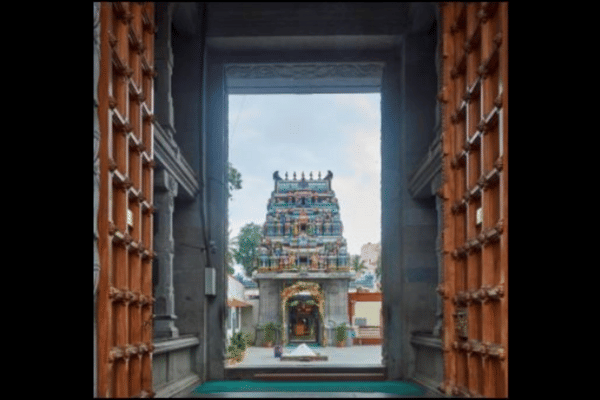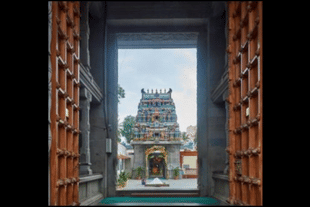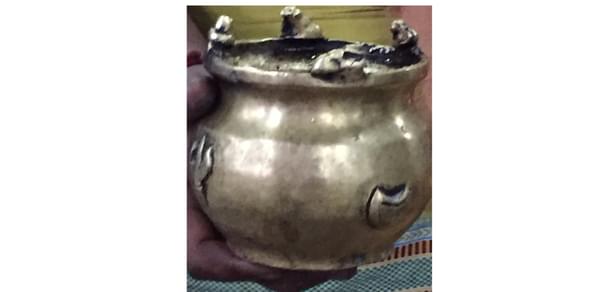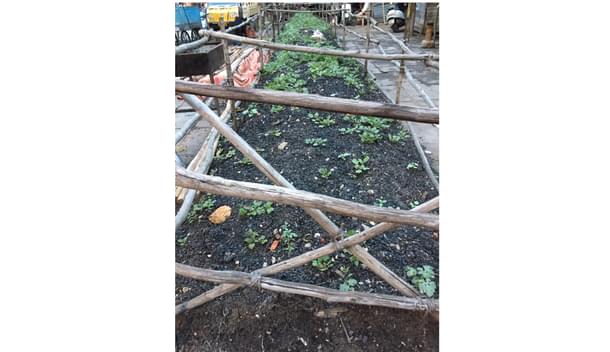Culture
The Guardian Deities Of Coimbatore: A Walk Through Divinity, Culture And History
Dhushyanthi Ravi
Dec 09, 2017, 02:26 PM | Updated 02:26 PM IST
Save & read from anywhere!
Bookmark stories for easy access on any device or the Swarajya app.


Coimbatore’s Devi temples find a place in the pan-Indian class of pilgrimage, like the Char Dham (Badrinath, Dwarka, Puri and Rameswaram) or the Nalambalam (four temples) yatra of Kerala, in spirit of purpose and veneration.
A temple walk along the old winding alleys of Tamil Nadu’s second-largest city brought to fore the unmistakable confluence of divinity, culture and history, and along the way, unravelled an everyday life that seemed to be semi-clad in a cryptic past.
The walk led to nine Devi temples, endearingly called the ‘nine sisters’ of Coimbatore, spread across the city (with seven of them huddled in the heart of the town). Most of old Coimbatore, which served as a garrison town for the powerful dynasties that ruled over it, is home to ancient temples that are patronised by a devout public and business houses for generations. Among these temples are those of the nine guardian deities, chief among them, the Koniamman.
The walk organised by ‘Do It All’, a Coimbatore-based events enterprise, and led by writer, and history and culture enthusiast, Rajesh Govindarajulu, took us to the heart of the city where we dodged vehicles and manoeuvred uneven kerbs to find ourselves in the pristine surroundings of the iconic Devi temples scattered across the mostly business and shopping cluster of the old town area. We alternated between a milieu of irate honking, billows of vehicular smoke and an environment of pealing of bells, resonating mantras from the hallowed sanctum, as we hopped from one temple to another.
Koniamman Temple
Koniamman Temple in Coimbatore’s Big Bazaar Street was consecrated for goddess Durga. It was built by then ruling clan Illangosar to shield a fort from an impending attack by the neighbouring kings from Kerala, and was named after the ruling deity, Koniamman. Since the temple was built to serve ‘strategic’ purposes, Koniamman’s role as the ‘guardian deity’ still continues with devotees thronging the large precincts in the heart of the city to pay obeisance to a goddess who has evolved to represent Mahishasura Mardini – the ugra avataram of the Devi. The temple was originally located in the north of Coimbatore, near a stream called Sanganur Pallam. It was built more than 1,500 years ago by the chieftain of the Irula community called Covan, from who the hamlet (puthur) derived its name, Covanputhur, today’s anglicised Coimbatore.
As we stepped into the temple through the imposing gateway, a mound of crystal salt mixed with whole black pepper greeted us. The salt ritual served to cast away evil eyes, Govindarajulu explained, as he took a fistful to demonstrate the practice. The Koniamman is a finely sculpted deity who holds in her eight hands the trident, udukkai (drum), sword, conch and discus, a skull, fire and a bell. Festivals in her honour are celebrated through the year.
An Aadi masa (July-August) feature is the oonjal (swing) fest. While Navaratri (September-October) is marked with great fervour, the annual car festival draws lakhs of devotees when the Devi is taken on a procession through the streets in the neighbourhood.
The temple, with its towering 85-foot raja gopuram built in 2014, has been adorned with three unique domes (kalasam) seated on its sanctum tower and paavai (lady) lamps in the manimandapam.
As we perambulated the precincts, I couldn’t help glancing at the massive rear wall a few metres beyond which a fort once stood, and which was razed to the ground by Tipu Sultan in 1793. Today, a middle-class apartment building has taken its place and its pale pink walls stood in stark contrast to the fort that served many a war – now relegated to the obliterated footprints of history.
Bhadrakali Amman Temple
The ancient Bhadrakali Temple on Vysial street is much sought-after for the divine energy it is believed to emanate, and the mystic tales surrounding it are as fascinating. It is said that devotees hear the jingling of Bhadrakali’s anklets. A brass pot (kalasam) containing theertham (holy water) is believed to possess healing powers. The pot of sacred water is believed to collect divine energy for a year, following which the priests distribute it to the devotees. Its miraculous powers are believed to cure pox among many other diseases. As the head priest held out the antique brass pot for us, we beheld it with utmost awe.

The temple hosts a clairvoyant, who was not in sight when we circumambulated the precincts hoping to catch a glimpse of him. The elderly priest’s prophecies were sought by devotees from far and wide, who vouched for their credibility.
Kamakshi Amman Temple
Located on Coimbatore’s Big Bazaar street, the more-than-a-thousand-year-old temple is ensconced in the jewellers headquarters of the city, and patronised by the craftsman of the region. Built completely out of granite stones, it bears the stamp of the Pallavas’ ancient Kanchi. A few decades ago, the temple structure was cleaned by using the sand-blasting technique that helped restore the ancient inscriptions, carvings and fresco to its most original form. However, its more modern structure built adjacently was starkly juxtaposed with the serene stone exterior of its ancient version.
Besides this temple, a few other Devi shrines we visited had some additional structures built or had received a fresh coat of paint, which veered me away for a moment to the temple renovation and expansion spree in the state that is mostly lending to the ‘functional’ value of the temple. Perhaps, it’s hard if not impossible to replicate the musical pillars of ancient shrines, which can be tapped to hear resonating notes or touched to feel the coolness even in the hottest of seasons. But, it’s intriguing to realise why modern technology is not able to, even in small measure, sustain the poise of temple architecture or worse still, is camouflaging traditional aesthetics in garish layers of paint.
Ankala Parameswari Temple
The temple on Vysial Street is the family deity of almost all the communities of Coimbatore. Donning a crimson interior and a well laid-out path for circumambulation, it’s said that reciting the mantra ‘Mathruka Stavam’ by Adi Shankara at this temple bestows great benefits and fortune. In the lanes surrounding the temple, one could lay her hands on rare vegetables, greens and flowers, the cultivation of which is irrigated by the Big Tank, a source that has been meeting all the water requirements of this part of the city.
Vasavi Kanikka Parameswari Amman Temple
Streets dedicated to jewellers led us to the eleventh-century incarnation of Devi – Vasavi Kanikka Parameswari. It would be a boon to set our eyes on her during Navaratri celebrations as the idol is bedecked with precious diamond and gem-studded jewels, giving out a radiance that is “equal to several suns”, says Govindarajulu. This Navaratri had devotees bustling around the ornate Devi to get a close glimpse of her turmeric-kumkum smeared countenance.
Coimbatore Delicacies
As we fed our appetite for piety, we paused to savour Coimbatore’s street food as well. We sampled steaming cups of paruthi paal payasam (cotton seed porridge), a lip-smacking delicacy, as we strolled. We also tucked into the celebrated settu billas dished out at a street stall. The crispy golden thattai (fried snack made of rice flour) sandwich with grated vegetable filling had us craving for more. As the twilight enveloped us, we queued up at a bustling paniyaram (savoury made of idli batter cooked in moulds) stall, where we took turns to relish the savoury doled out at a blistering pace on paper plates served with spicy chutneys.
Ramalinga Sowdeswari Temple
The black soil of Coimbatore encouraged the weavers of Andhra Pradesh to migrate to the city during the rule of Vijayanagara kings, and along with them came Devi Sowdeswari, who is now the presiding deity of Ramalinga Sowdeswari temple in the Raja Street area. With cotton aplenty, the weavers never ran out of raw material and excelled at producing fabric for turbans.
The weaver community of Devangas celebrated the deity, the provider of sowbhagya and sarvamangala, says Govindarajulu, conducting Navaratri and annual festivals, the long processions and ceremonies of which culminated at the temple. The businessmen of the area attributed their prosperity to the blessings of this reigning deity. It has to be highlighted here that the Ramalinga Sowdeshwari temple underwent major renovation keeping the number of trees that were felled to make space for construction to the minimum.
Maakali Amman Temple
The deity of tutelage is located in a small lane that displays a riot of colour as the centuries-old temple is in the bustling flower market area of Coimbatore, known for its flourishing trade in flowers. The several varieties of flowers wafted the fragrance to us as we entered the temple. The deity is pampered with garlands of lemon and families take a fruit home which they preserve, as they believe it serves as a talisman for protection. The Arasamarathu Vinayakar (peepal tree Ganesha) sits, almost hidden, at the base of the 200-year-old tree, which is a much sought-after shrine of the locals.
Dandu Mariamman Temple
The Dandu Mariamman temple is 250 years old and stands tall on one of the main arterial roads of Coimbatore – the Avinashi Road. Govindarajulu traced the origin of the temple with an interesting piece of history. Pallava rulers used this corridor to enter Coimbatore with their armies, and centuries later, the Uppilipalayam part of Avinashi Road played host to armies on the move, and the place was christened dandu, which is a vernacular term for army. A legend, Govindarajulu said, has it that the Devi appeared in the dream of a devotee, who was a soldier, and directed him to find her amidst neem trees and close to a water source, which the soldier did, and built a temple for the Devi. It is believed that she has great healing powers and devotees sought her blessings for curing serious illnesses.
Draupadi Amman Temple
The more-than-300-year-old temple is dedicated to Draupadi Amman and along with a shrine for her consort Dharmaraja, is largely associated with the Mahabharata. Gifted with an aptly named well, Pandava Theertham, the newly restored paintings on the temple walls depict scenes from the Mahabharata. The annual firewalk or gundam during the Tamil month of Maasi (March) is the most important event on the temple’s calendar. The 60-foot-long mud platform built for the firewalk is the longest in Coimbatore. When the group crowded around it for a closer look, we saw green shoots had sprouted on the platform that springs to life once a year when devotees walk barefoot on the smouldering bed of glowing embers.

True to the spirit of the epic, the firewalk ritual gets the nod following the observance of two customs. The stacking of logs for the walk begins only after the arrival of a transgender, and on the melting of the butter applied on Dharmaraja’s face.
The temple walk concluded at the Coimbatore Manikoondu (clock tower) and we felt a pervasive sense of gratification at having been transported to different eras of history by way of ancient shrines that had kept alive cultural practices besides inspiring a sense of divinity.
This article is part of the Swarajya heritage programme. If you liked this article and would like us to do more of the kind, consider being a sponsor – you can contribute as little as Rs 2,999. Read more here.
Also Read:





